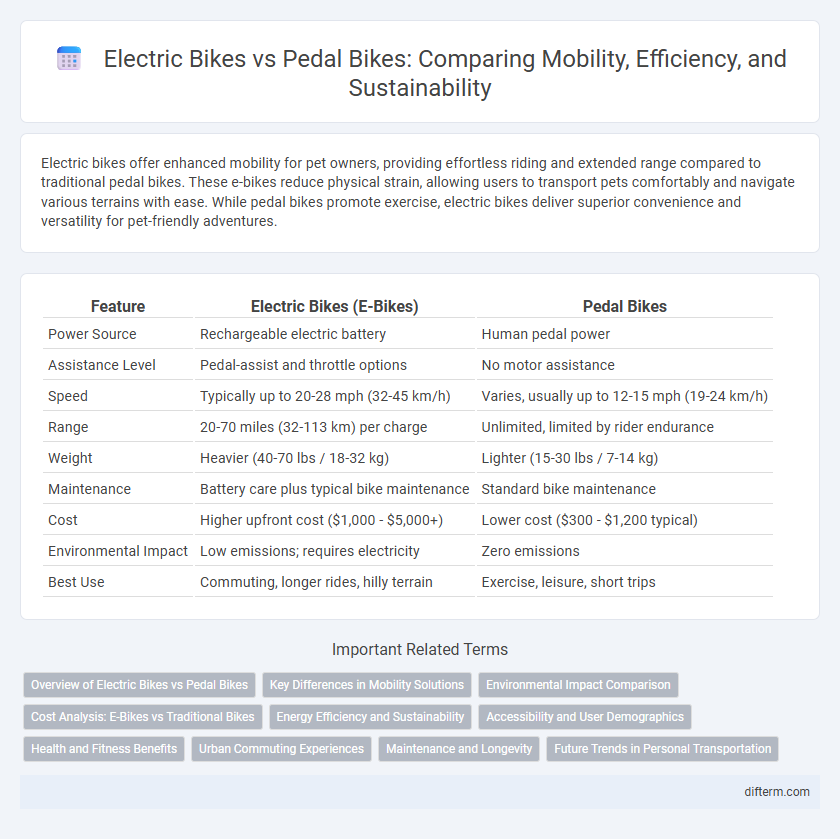Electric bikes offer enhanced mobility for pet owners, providing effortless riding and extended range compared to traditional pedal bikes. These e-bikes reduce physical strain, allowing users to transport pets comfortably and navigate various terrains with ease. While pedal bikes promote exercise, electric bikes deliver superior convenience and versatility for pet-friendly adventures.
Table of Comparison
| Feature | Electric Bikes (E-Bikes) | Pedal Bikes |
|---|---|---|
| Power Source | Rechargeable electric battery | Human pedal power |
| Assistance Level | Pedal-assist and throttle options | No motor assistance |
| Speed | Typically up to 20-28 mph (32-45 km/h) | Varies, usually up to 12-15 mph (19-24 km/h) |
| Range | 20-70 miles (32-113 km) per charge | Unlimited, limited by rider endurance |
| Weight | Heavier (40-70 lbs / 18-32 kg) | Lighter (15-30 lbs / 7-14 kg) |
| Maintenance | Battery care plus typical bike maintenance | Standard bike maintenance |
| Cost | Higher upfront cost ($1,000 - $5,000+) | Lower cost ($300 - $1,200 typical) |
| Environmental Impact | Low emissions; requires electricity | Zero emissions |
| Best Use | Commuting, longer rides, hilly terrain | Exercise, leisure, short trips |
Overview of Electric Bikes vs Pedal Bikes
Electric bikes feature a battery-powered motor that assists pedaling, enhancing speed and reducing physical effort, which appeals to commuters and long-distance riders. Pedal bikes rely solely on human power, offering simplicity, lower maintenance costs, and environmental benefits through zero emissions. When comparing electric bikes to pedal bikes, factors such as range, speed, cost, and exercise benefits play crucial roles in consumer decision-making.
Key Differences in Mobility Solutions
Electric bikes offer enhanced mobility by integrating battery-powered motors that assist pedaling, enabling longer distances and easier hill climbs compared to traditional pedal bikes. Pedal bikes rely solely on human power, which limits speed and range but provides a lightweight and cost-effective transportation option. The choice between electric and pedal bikes significantly impacts urban mobility solutions, with e-bikes promoting faster commutes and reduced physical strain.
Environmental Impact Comparison
Electric bikes produce significantly lower carbon emissions compared to cars, but their environmental impact depends on battery production and electricity source. Pedal bikes offer zero emissions during use and require fewer resources to manufacture, making them the most eco-friendly option for short-distance transportation. Life cycle assessments show that while electric bikes have a higher impact than pedal bikes, they still contribute to reducing urban air pollution and fossil fuel dependence.
Cost Analysis: E-Bikes vs Traditional Bikes
Electric bikes typically have a higher upfront cost, ranging from $1,000 to $3,000, compared to traditional pedal bikes priced between $300 and $1,000. Maintenance expenses for e-bikes can be more costly due to battery replacements and specialized components, whereas pedal bikes incur lower repair and upkeep costs. Despite the initial investment, e-bikes offer savings on fuel and reduced commuting time, which can offset expenses over time.
Energy Efficiency and Sustainability
Electric bikes consume significantly less energy per mile compared to cars, making them a highly energy-efficient transportation option. Pedal bikes, requiring no external energy source, offer zero emissions and contribute to greater sustainability by reducing carbon footprints. Both modes promote eco-friendly urban mobility, but pedal bikes remain superior in minimizing environmental impact due to their complete reliance on human power.
Accessibility and User Demographics
Electric bikes expand accessibility by reducing physical exertion, making cycling feasible for older adults, commuters, and individuals with mobility challenges. Pedal bikes primarily attract fitness enthusiasts and experienced cyclists due to the physical effort required. The growing adoption of electric bikes in urban areas highlights a demographic shift towards inclusive, sustainable mobility solutions.
Health and Fitness Benefits
Electric bikes offer enhanced cardiovascular benefits by encouraging longer rides and increased physical activity compared to traditional pedal bikes, which rely solely on rider power. Pedal bikes provide more intense exercise, promoting greater muscle strength and endurance through continuous pedaling effort. Combining electric bike assistance with regular pedaling can optimize health outcomes by balancing aerobic exercise and muscle engagement.
Urban Commuting Experiences
Electric bikes enhance urban commuting by reducing travel time and minimizing physical exertion, making them ideal for longer distances and hilly terrains. Pedal bikes offer greater exercise benefits and lower costs, appealing to commuters prioritizing health and sustainability. Both modes improve traffic congestion and environmental impact, but e-bikes provide a more accessible option for diverse urban populations.
Maintenance and Longevity
Electric bikes require specialized maintenance for battery care, motor upkeep, and electronic components, which can increase costs and complexity compared to pedal bikes. Pedal bikes have simpler mechanical systems like chains and brakes, making repairs more affordable and easier to perform. Longevity of pedal bikes often surpasses electric bikes due to fewer electronic parts prone to wear and obsolescence over time.
Future Trends in Personal Transportation
Electric bikes are rapidly gaining traction due to advancements in battery technology and increased urbanization, offering a sustainable alternative to traditional pedal bikes for short to medium commutes. Integration with smart city infrastructure and IoT connectivity enhances route planning and safety, making e-bikes a key component in future personal transportation ecosystems. Rising environmental concerns and government incentives continue to drive the shift toward electric mobility solutions, positioning e-bikes as a dominant mode in urban transport landscapes.
electric bikes vs pedal bikes Infographic

 difterm.com
difterm.com